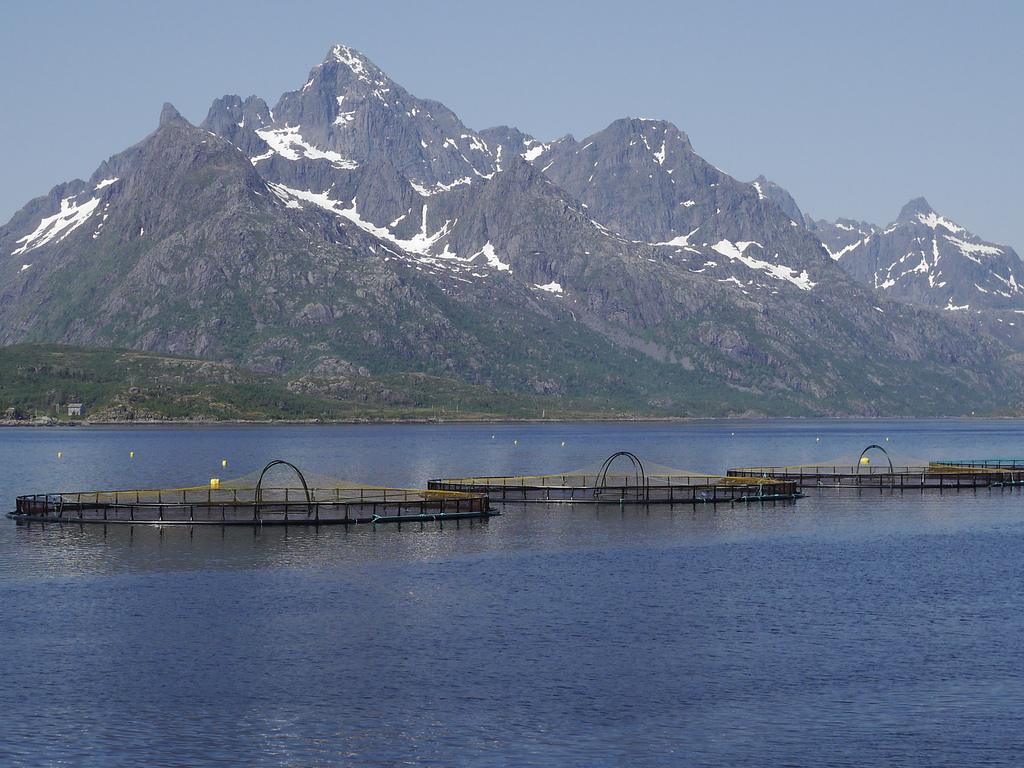In Norway, fish parasites are fought with underwater laser robots

In some fjords of Norway and a number of water bodies in Scotland, strange green flashes can be observed in the water in the evening and at night. These flashes are pretty bright, and you can see them often. An uninitiated person will think that the matter is in extraterrestrial life or this is a manifestation of the activities of otherworldly forces. But in fact, everything is much simpler and more down to earth. These flashes are traces of the struggle of entrepreneurs with the parasites of fish. Namely - pests that are attached to the skin of salmon on salmon farms. These parasites, if nothing is done with them, can reduce the fish population in a relatively short time. Even in nature, they are dangerous, because if several such organisms stick to the skin at once, the salmon gradually lose strength and may die.
But in nature, fish are dispersed in the aquatic environment. But on salmon farms they are kept in a heap, so the harm caused by parasites is much harder than what happens in nature. This is a subclass of crustaceans from the class Maxillopoda. Most groups of copepods are ectoparasites of invertebrates and vertebrates. Two species of copepods, Lepeophtheirus salmonis and Caligus elongatus attack salmonids and some other species of fish, attaching to the body. These parasites feed on the blood and tissues of the host, so exceeding a certain number of parasites on the body of one fish (usually the number of 10 organisms per medium fish is critical) threatens the host with death. Fighting these parasites until a certain point was almost impossible. But modern technology has helped find a reliable solution.

"Salmon lice" (Lepeophtheirus salmonis, den. Siphonostomatoida)
')
Farmers usually keep in a limited amount of water (special “cages” in the middle of an open reservoir) from 50,000 to 150,000 fish. If parasites appear, they very quickly infect the vast majority of the population. Salmon start to hurt, grow slowly and die in severe cases. Farmers, respectively, receive significant losses.
But, as mentioned above, a way out of this difficult situation has been found . These are underwater robots with laser weapons. It would seem fiction, but no - this is a very real method that is used on many fish farms in Norway and Scotland. The decision did not appear immediately, it was sought for several years. In the end, the problem was solved by the Norwegian company Beck Engineering from Oslo. She developed an underwater robot with two stereo cameras, a laser and a motion system.
Cylindrical robot suspended by buoy. The device is equipped with video cameras, which allow the system to analyze the appearance of salmon passing by. If a parasite is detected, it is immediately struck by a green laser beam. The impulse is powerful and short-term: it kills the parasite, but does not harm the fish. According to the developers, just one device can kill tens of thousands of sea lice in a day. The fish in the farms live quite tightly, so most of the inhabitants of the “cage” swim past the robot in a day.
The laser, which is used to combat parasites, is not quite normal. This is a diode laser, which is used in such fields of medicine as hair removal, ophthalmology, dentistry. The robot is controlled by a special computer, the software of which is able to analyze the images received from the cameras in real time. The drone is powered from an external source, voltage - 220 volts.
The principle of image recognition is similar to the principle laid down in the software platform for recognizing the face of the owner in modern smartphones and laptops. But it all works a little faster, because the goal is not static. The software analyzes the video stream transmitted by the drone's cameras, and if the computer receives a signal, the laser system starts working, which emits a green beam with a wavelength of 530 nm. The parasite dies when the "shot" from a distance of 2 meters and closer.
When analyzing the situation on the farm, water temperature, oxygen concentration and some other factors are assessed. Without this, the laser system will not be able to accurately hit the target. Now this technology is used by the largest players in the fish market, including the Lerøy Seafood Group, Marine Harvest, and SalMar. Robots that fight parasites are called Stingray. They were first introduced in 2014, now they are used on 100+ farms in Norway. Last year, Scotland’s fish farms began to work with them.
Previously, parasites fought fish, but for this, salmon were caught, unloaded on board a special ship, where they passed through streams of hot water with the addition of various chemicals. It was effective, but this option was quite expensive for farmers. Now everything is faster and more efficient.
By the way, according to the authors of the New York Post, the prices for salmon over the past few years could increase precisely because of sea lice, which caused considerable damage to fish farms. It is possible that robots with laser systems can not only help farms, but also help reduce the price of fish. Although this is another question.
Source: https://habr.com/ru/post/402797/
All Articles